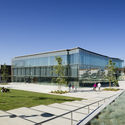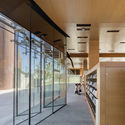
-
Architects: HED, Johnson Favaro
- Area: 21000 ft²
- Year: 2014
-
Photographs:Eric Staudenmaier
-
Manufacturers: AutoDesk, Kingspan Light + Air, Vitrocsa, Cristacurva
-
Lead Architects: Choong Kim

Text description provided by the architects. HED worked as executive architect in collaboration with Johnson Favaro on this 21,000 SF, two-story library with panoramic ocean views. HED designed the double façade described below to recover heat gain and reduce maintenance costs. The program also included associated site improvements, access ramps, walkways, landscaping and underground utilities.



























